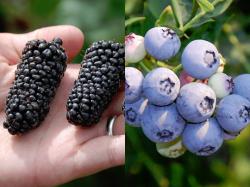Two Tasty New Berries From USDA Agricultural Research Service
September 8, 2016 | 1 min to read

Agricultural Research Service (ARS) geneticist Chad Finn and his colleagues at the Horticultural Crops Research Unit in Corvallis, Oregon, developed two new berry varieties—a blueberry and a blackberry—that were recently released to the public.
Up until the early 1900s, blueberries were picked from the wild, and the bushes often did not survive when transplanted elsewhere. True domestication-involving propagation of the plant by the grower and plant breeding to improve desirable traits-was beyond reach until 1910. That's when USDA botanist Frederick Coville discovered that blueberry bushes require moist, acidic soil to thrive. In 1916, exactly a century ago, the first commercial cultivated crop of highbush blueberries was harvested.
That history is now enhanced by Baby Blues, a cultivar released in cooperation with the Oregon State University's Agricultural Experiment Station and the Washington State University's Agricultural Research Center. This new blueberry is making its debut during the 100th anniversary of the first cultivated blueberry crop to go to market.
To read the rest of the story, please go to: USDA AgResearch Magazine
